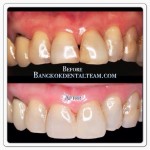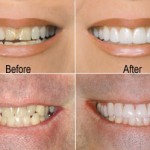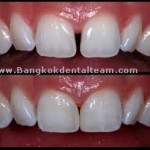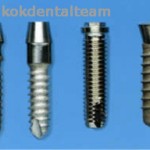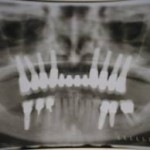Archive for August, 2013
-
Teeth Bleaching (Teeth Whitening)
-
Dental Laminated Veneer
Veneers are done to cover teeth discoloration.
Q : What is “Veneer”?
A : A “Veneer” is an artificial enamel showing in the front and is made of plastic or ceramic in order to substitute a real surface of a natural tooth which might be loss or has an unwanted discoloration.
Q : How many types of Veneers are there? And what are they?
A : There are 2 major types of “Dental Veneers” classified by the process of making a veneer.
Direct Veneer : made directly inside the mouth
Indirect Veneer : made in the laboratory and delivered to the mouth.
If classified by material used for making a veneer, there are 2 types of material used:-
Resin Composite
Ceramic or Porcelain
Q : Which type is best?
A : Veneers are made for the same purpose, no matter what they are made from. Since Ceramic or Porcelain are more esthetic, natural-like, and stronger than resin, a choice of Ceramic or Porcelain Veneers are selected when esthetic and strength are major concerns. However, they are pricier than that of resin and consume more dental visits due to the fact that there are laboratory procedures. On the contrary, resin type can be done directly inside the mouth and can be finished in one setting. Therefore, if you have limited time and budget, while getting an acceptable esthetic, then a choice of resin type can be selected.
There is, however, another type of resin veneer that is made from the laboratory which will give more esthetic and strength, but still cannot compare to that of a ceramic type.
Q : When is the time for Veneers?
A : Veneers are usually made on the front teeth area or on all visible areas – especially when smiling or speaking. When having tooth surface loss, filling up the area may not yield esthetic result or not so strong, or in case of tooth discoloration and teeth whitening cannot efficiently work, Veneers can be used in these cases.
picture1 Veneers are done to cover teeth discoloration.
Besides, Dental Veneers can be made when teeth are not in good alignment, such as, spacing or crowding. Veneer shape can be designed to cover the spacing or the crooked area. However, veneer should be done for minor correction of teeth mal-alignment only, not severe case which can be corrected by some other means, such as, orthodontics, false teeth, etc.
picture 2 High canine has been extracted and cover the spaced area with a veneer to have a harmonized look without having to undergo orthodontic treatment.
picture 3 Spaced teeth can be covered using Dental Veneers resulting in a better smile.
-
Dental Implants
Q : What is a Dental Implant?
A: Different types of screw implants
An implant is an artificial root made from a biocompatible material that is implanted to replace lost teeth. Standard implants today are screw or cylinder form made from titanium.
Titanium is a unique metal: It can be incorporated in the bone without an intermediate layer. This intimate contact between bone and titanium is called osseointegration. Another advantage of titanium is it does not cause allergic reactions, rejection, nor inflammation of the oral mucosa. Because of its biocompatible qualities, titanium is broadly used for other medical implants, for example hips, knees, etc.
Normally, dental implants have a length of 6-15 mm and a diameter of 3-5 mm. On the market there are numerous companies producing implants, but only few systems are supported by scientific studies and long-term results
Q : How is an Implant Placed?
A: Careful planning is the first step preceding an implant operation. With help from x-rays and study models, the amount of bone is measured in length and width, so the ideal position for a suitable implant can be planned.
A : Implantation is a surgical intervention performed under sterile conditions that can take between 45-90 minutes. Implantation can be done without pain using local anesthesia. Nevertheless, the procedure can be stressful for some patients. For this reason, we offer treatment to be done under conscious sedation, using nitrous oxide (laughing gas) or other sedatives. The advantage is complete relaxation and comfort for the patient.
For larger operations, like bone augmentation, or for dental phobic patients, we can also offer general anesthesia. An expert team of anesthesiologists can accompany us within the Clinic St. Anna, or in our private practice.
After the gum tissue is numb, it is carefully opened. With a sequence of calibrated burs, the implant bed is prepared. To prevent overheating of the bone, preparation is done with sterile water cooling. The suitable implant is chosen and placed. The gum tissue is sutured over the implant and a temporary prosthesis or bridge is seated.
-
Orthodontic Treatment (Braces)
Q : Is it necessary to have teeth pulled in every orthodontic case?
A : Generally, orthodontics needs to have movements of teeth. In case of very little space for such movements, for example, crowded teeth, then it is necessary to gain space for teeth to be able to move. This can be done by either having some of the teeth pulled out or reducing the size of some teeth. If there is enough space, for example, some teeth had been pulled out, have missing teeth, or generally spacing, then it may not be necessary to pull out more teeth.
Q : What about wisdom teeth? Do they need to be removed before braces?
Or can be done afterward?
A :
“Wisdom teeth” have never been wanted by any dentists; therefore, even if not having orthodontic treatment, they are strongly recommended to be removed. This is to help make the cleaning inside the oral cavity easier and more thoroughly. However, the necessity of wisdom teeth removal depends on many factors; for example, age, teeth and gum condition, etc., which the dentist will evaluate individually.
Oral care in those who have orthodontic appliances in the mouth is more complicate than in those who do not have. If there is any wisdom teeth that are hard to take care of, the teeth are usually advised to be taken out. This is not just for orthodontic purpose, but also for a better oral hygiene. If found that the wisdom teeth may come up in a direction which can push other teeth out of the alignment, then to remove the wisdom teeth prior to or during orthodontic treatment is recommended. If not, then after orthodontic treatment is done, the well-aligned teeth may move to undesired position causing problems of rotated or crooked once again and the patient needs to come back to redo the braces all over again to straighten the teeth. This time, the orthodontic process maybe more complicated than the first time. Wearing retainers is still necessary as retainers can help keeping the teeth into their aligned position although the wisdom teeth have not yet been removed. The problem of crowding is likely not easy to occur. Nevertheless, to remove the wisdom teeth is still recommended – especially, when the wisdom teeth have erupting direction that can push other teeth to move out of alignment.
Pages
- Gallery
- Testimony
- Our Dentists
- Store
- Our Place & Facilities
- Interesting places nearby
- Knowledge
- Technology
- SERVICE
- Services
- Price
- Appointment
- Promotion
- About us
- Map
